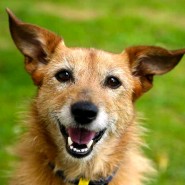
Animal Wellness Magazine.
Training is necessary, and the lessons you teach him should be practiced regularly. Here are the five best times of day to do it.
Finding the opportunity for training can be a challenge, but this article will help with useful tips on the five best times to work on your best friend’s training and obedience.
Training Time: First things first – the three “E”s
There are three things dogs want to do in the morning: eliminate, eat and explore (the three “E”s). Use this time to practice training by asking your dog to sit, lie down or stay before granting his desires. This category is related to “Best Time 3”, but is especially important so it has its own category.
Training Time 2: During the day “captures”
Capturing the behaviors your dog spontaneously performs is one of the easiest and quickest methods you can use to train him. Simply watch him, and whenever he does something you want, praise him and toss him a treat. Over time, he will start offering the behaviors more frequently. Then it’s simply a matter of weaning him off the treats.
The six “capture” behaviors we stress in our training classes are:
Sitting
Lying down
Going to bed
Picking up a toy
Walking by your side
“Checking in” (the most important — whenever your dog glances up at you before doing anything)
Remember to jackpot the “aha” moment when the dog finally “gets” what the game is. An example is when a guest walks in the door and your dog, without being asked, pauses, lies down and looks at you. Super praise and multiple treats should rain from the heavens! That’s a jackpot.
Training Time 3: During the day “cues”
You don’t want to have to carry treats around with you for the rest of your life. Thus it’s important to ask your dog to do one of the behaviors you’ve been capturing throughout the day and use “life rewards” instead. Life rewards are anything your dog wants that isn’t food:
Want to go outside? Sit first.
Want to chase the ball? Lie down first.
Want to get on my bed? Go to your bed first.
Want to sniff the fire hydrant? Walk ten steps by my side first.
Training Time 4: Immediately after an unwanted behavior
If your dog steals food off the table, runs out the door or jumps on you, it indicates one of two problems — the behavior has not been properly managed/prevented, or you haven’t taught the dog an appropriate substitute behavior. Prevention and management refer to the proper use of tethers, baby gates and exercise pens. Substitution simply entails teaching the dog what you’d like him to do instead.
The 60 seconds immediately following an unwanted behavior is the perfect time for training – it’s fresh in your mind and in your dog’s. Taking one minute to teach your dog to “leave it” when food is placed on the table, or to lie down and stay when the door opens, helps both of you become more aware. In short order, the new behavior becomes more reliable.
Training Time 5: The witching hours
Parents often call the hours between 4pm and 9pm the “witching hours” because they notice a real energy uptick in their children. In the canine world, it’s called the “crepuscular” time. Think of it as the time of day when Mother Nature is screaming in your dog’s ear: “Your ancestors were wolves! Go hunting!”
The trick is for you to harness your dog’s sudden burst of energy and use it as a training opportunity. Take your dog for walks or runs, play hide-and-seek or fetch, and teach him to hunt treats around the house or yard. All these are easier when your dog is already geared for action.
How do you turn the switch off when it’s time to settle down for the night? Just because you’re ready to stop doesn’t mean your dog is. The easiest way to teach a dog an “off switch” is to say something like “that’s it” or “all done” and have him run to his bed and lie down. Then get a long-lasing treat like a good quality bully stick or a treat-filled Kong. The dog’s chewing will actually help dissipate that last bit of energy.
Taking advantage of these ideal times for training will keep your dog sharp and well-behaved, and strengthen your bond of friendship.